

Oil and its derivatives represent Ecuador’s main source of income; its exploitation ranges between 43% and 66% of total exports and contributes between 43% and 59% of the nation’s total budget(1).
History of oil exploitation in Ecuador
In the Ecuadorian Amazon, oil exploitation began in 1967 by the U.S. company Texaco, followed by the construction of the Trans-Ecuadorian Oil Pipeline System and the Via Coca.
In 1989, the state-owned company Petroecuador was created, which divided the oil exploitation zones into so-called rounds or blocks that occupy an area of 4.2 million hectares, of which approximately 3.5 million are part of the Ecuadorian Amazon.
Explorations to locate crude oil in the Amazon began in the 1950s, first encountering heavy oil deposits located in the south central Amazon. indigenous peoples that inhabit this area of the jungle.The efforts were therefore shifted to the northern zone where light crude oil and less aggressive indigenous communities would be found.
The hydrocarbon exploration and exploitation phases have been dominated since 1981 by transnational companies such as Texaco, Repsol, Petrobras, Perenco, Andes Petroleum, City Oriente, among others. These companies benefited from the Ecuadorian government’s provision of 200,000 hectares each to exploit oil in protected areas of the Amazon such as the Yasuní National Park.
In 1986, work began in these areas and the state modified the laws protecting the protected areas and even changed the limits of the national parks in order to carry out oil exploitation.
Currently, 11 transnationals hold concessions to exploit 15 blocks and the state-owned Petroecuador operates in 700,000 hectares(2). These companies together produce around 500,000 barrels of oil per day for Ecuador.
Control of oil companies over the Amazon
The state’s permissiveness was quickly taken by the companies as an excuse for total control of the exploitation zones, to the point of regulating the passage of inhabitants through their lands, as happened in Yasuní National Park by Repsol, from whom the inhabitants had to request permission to enter.
This controlling attitude generated unrest among the indigenous populations and when the state tried to continue granting concessions in the Puyo area, the Kichwa, Shuar and Achuar ethnic groups formed a resistance that prevented the companies from operating.
August 26, 2022

Cofán, an indigenous people between Colombia and Ecuador
May 28, 2022
Shiwiar – Amazon Rainforest People from Ecuador
In the areas of exploitation, the companies have tried to link up with the population, offering some handouts or social aid that in most cases turn out to be just crumbs compared to the profits of the multinationals, which at one point reached 80% for the company and 20% for the state.
Due to the Ecuadorian government’s abandonment of vulnerable populations, they see in the oil companies a kind of salvation in times of extreme need, and the companies take advantage of this condition to save the social commitments that the laws impose on them.
Another point established by the compensation laws is the hiring of the indigenous population and the companies use them as cheap labor in physically demanding jobs, such as cleaning roads or manual excavations, and when a spill occurs, it is the indigenous people who are employed to carry out the decontamination, many times without adequate protective equipment. (3)
Socio-environmental impact of hydrocarbon extraction in Ecuador
Damage is present from the previous phases of exploration, extraction and transfer of crude oil. During exploration, contacts are made with the communities that are subjected by the companies to various control methods to avoid any resistance.
At the ecosystem level, damage begins with the opening of roads to access the deposits, which implies deforestation and damage to the fauna of the area. Invasive techniques such as the use of explosives are used to locate the wells.
With extraction, the oil seeps into the groundwater reserves and in the separation processes the contaminated water ends up in the rivers. The gas that is extracted as a by-product ends up being flared, releasing pollutants into the atmosphere that cause acid rain that ends up affecting dozens of hectares around each extraction well.
This does not include oil spills, which between 1994 and 2002 amounted to 779, an average of 92 per year and 8 per month. There is no exploitation without multiple damages to people and the environment.
As evidence of the damage suffered by the country due to uncontrolled exploitation, the case of Texaco stands out. During the 28 years of its contract in Ecuador, it is estimated that it dumped 5,000,000 gallons of production waste per day into the environment, burned 10,000,000 cubic feet of gas daily, dumped 16.8 million barrels of oil and deforested more than one million hectares of forest in the Amazon jungle.
These devastating figures fall short when measuring the impact on indigenous communities that even today continue to be affected by the loss of their habitat and countless diseases that have wiped out entire ethnic groups, as in the case of the Tetete and Sansahuari.
The lawsuit in the United States for damages caused to Ecuador is valued at US$6 billion.
Sources
Guaranda, W. (2011). Notes on oil exploitation in Ecuador. Justicia Ambiental, bulletin of communities fighting for comprehensive environmental remediation. (S/f-b). Inredh.org. Retrieved April 20, 2022, from https://www.inredh.org/archivos/pdf/boletin_petroleo_apuntes.pdf.
Vogliano, S. (2009). Ecuador-Oil extraction in the Amazon. Socio-ecological conflicts. Fossil fuels. (S/f-c). Fuhem.es. Retrieved April 20, 2022, from https://www.fuhem.es/media/ecosocial/image/culturambiente/fichas/ECUADOR_combustibles_n22.pdf.
Aggressive expansion of oil exploitation on indigenous lands in Ecuador. (n/d). openDemocracy. Retrieved April 20, 2022, from https://www.opendemocracy.net/es/agresiva-expansion-petroleo-tierras-indigenas-ecuador/.
MALDONADO, Adolfo; NARVAEZ. Alberto. 2003. Ecuador is not, nor will it ever be, an Amazonian country. Inventory of petroleum impacts -1. Edil. Ecological Action. Quito. Ecuador. https://www.accionecologica.org/ecuador-ni-es-ni-sera-ya-pais-amazonico-inventario-de-impactos-petroleros/
Por, E., Maldonado, A., Almeida, A., Ecológica, A., Martínez, E., Rivasés, M., Weigerther, R., Proaño, J., Pixley-Fink, E., Grunwald, P., Kaplan, R., Scheu, J., Maldonado, P., Alvarado, M., Bravo, L., Sud, A., & Lazzio, R. (n/d). Title: Atlas Amazónico del Ecuador: Agresiones y resistencias. Subtitle: Inventory of oil impacts -2. Accionecologica.org. Retrieved June 21, 2022, from https://www.accionecologica.org/wp-content/uploads/LIBRO-ATLAS-AMAZONICO-DEFINITIVO.pdf.

Gerson Alvarado, Comunicador Social egresado de la ULA Táchira, Venezuela. Actualmente desempeñando funciones de Comunicador y Reportero Audiovisual. Fotógrafo, Músico y Ciclista. Apasionado por captar imágenes de paisajes y documentar historias.
This post is also available in:
![]() Español (Spanish)
Español (Spanish)
